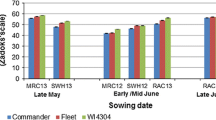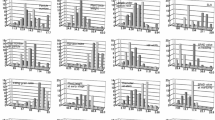Abstract
Delayed leaf-senescence, or stay-green, has been regarded as a desired characteristic for the production of a number of crops including rice. In this study, we analyzed the genetic basis of stay-green using a population of 190 doubled haploid lines from the cross between an indica parent Zhenshan 97 and a stay-green japonica parent Wuyujing 2. The population was tested in replicated field trials in 2 consecutive years, and six traits were defined to evaluate the stay-green characteristics. A genetic linkage map with 179 SSR (simple sequence repeat) marker loci was constructed. The software QTLMapper, based on a mixed linear model approach, was applied to detect QTLs, epistatic effects and their environmental interactions for these traits. A total of 46 main-effect QTLs was detected for the six traits that can be localized to 25 chromosomal regions. The individual effects of all the QTLs were small. Fifty digenic interactions were resolved that involved 66 loci distributed on all 12 chromosomes. Environmental interactions were detected for 18 of the main-effect QTLs and 14 of the epistatic interactions. Collectively, the epistatic effects and QTL by year interactions accounted for large proportions of the phenotypic variations. The results also showed that most of the stay-green traits were negatively correlated with yield and its component traits. The implications of the results in crop improvement were discussed.

Similar content being viewed by others
References
Ambler JR, Morgan PW, Jordan WR (1987) Genetic regulation of senescence in a tropical grass. In: Thomson WW, Nothnagel EA, Huffaker RC (eds) Plant senescence: its biochemistry and physiology. American Society of Plant Physiologists, Rockville, Maryland, USA, pp 43–53
Bassam BJ, Anolles GC, Gresshoff PM (1991) Fast and sensitive silver staining of DNA in polyacrylamide gels. Anal Biochem 196:80–83
Bolanos J, Edmeades GO (1996) The importance of the anthesis-silking interval in breeding for drought tolerance in tropical maize. Field Crop Res 48:65–80
Borrell AK, Hammer GL, Henzell RG (2000) Does maintaining the green leaf area in sorghum improve yield under drought? II. Dry matter production and yield. Crop Sci 40:1037–1048
Buchanan-Wollaston V (1997) The molecular biology of leaf senescence. J Exp Bot 307:181–199
Causse MA, Fulton TM, Cho YG, Ahn SN, Chunwongse J, Wu K, Xiao JH, Yu ZH, Ronald PC, Harrington SE, Second G, McCouch SR, Tanksley SD (1994) Saturated molecular map of the rice genome based on an interspecific backcross population. Genetics 138:1251–1274
Cha KW, Koh HJ, Lee YJ, Lee BM, Nam YW, Paek NC (2002) Isolation, characterization, and mapping of the stay-green mutant in rice. Theor Appl Genet 104:526–532
Crasta OR, Xu WW, Rosenow DT, Mullet J, Nguyen (1999) Mapping of post-flowering drought-resistance traits in grain sorghum: association between QTLs influencing premature senescence and maturity. Mol Gen Genet 262:579–588
Fang Z, Bouwkamp JC, Solomos T (1998) Chlorophyllase activities and chlorophyll degradation during leaf senescence in the non-yellowing mutant and the wild-type of Phaseoulus vulgaris L. J Exp Bot 49:503–510
Gan S, Amasino RM (1995) Inhibition of leaf senescence by autoregulated production of cytokinin. Science 270:1966–1967
Gentinetta E, Ceppi D, Lepori C, Perico G, Motto M, Salamini F (1986) A major gene for delayed senescence in maize. Pattern of photosynthates accumulation and inheritance. Plant Breed 97:193–203
Guiamet JJ, Giannibelli MC (1996) Nuclear and cytoplasmic “stay-green” mutations of soybean alter the loss of leaf soluble proteins during senescence. Physiol Plant 96:665–661
Guiamet JJ, Teeri JA, Nooden LD (1990) Effects of nuclear and cytoplasmic genes altering chlorophyll loss on gas exchange during monocarpic senescence. Plant Cell Physiol 31:1123–1130
Guiamet JJ, Schwartz E, Pichersky E, Nooden LD (1991) Characterization of cytoplasmic and nuclear mutations affecting chlorophyll and chlorophyll-binding proteins during senescence in soybean. Plant Physiol 96:227–231
Harushima Y, Yano M, Shomura A, Sato M, Shimano T, Kuboki Y, Yamamoto T, Lin SY, Antoni BA, Parco A, Kajiya H, Huang N, Yamamoto K, Nagamura Y, Kurata N, Khush GS, Sasaki T (1998) A high-density rice genetic-linkage map with 2,275 markers using a single F2 population. Genetics 148:479–494
Lander ES, Botstein D (1989) Mapping Mendelian factors underlying quantitative traits using RFLP linkage maps. Genetics 121:185–198
Lincoln S, Daly M, Lander E (1992) Constructing genetics maps with MAPMAKER/EXP 3.0. Whitehead Institute Technical Report, Whitehead Institute, Cambridge, Massachusetts, USA
McCouch SR, Teytelman L, Xu Y, Lobos KB, Clare K, Walton M, Fu B, Maghirang R, Li Z, Xing Y, Zhang Q, Kono I, Yano M, Fjellstrom R, DeClerck G, Schneider D, Cartinhour S, Ware D, Stein L (2002) Development and mapping of 2,240 new SSR markers for rice (Oryza sativa L.). DNA Res 9:199–207
Murray M G, Thompson W F (1980) Rapid isolation of high-molecular-weight plant DNA. Nucleic Acids Res 8:4321
Nakamura M, Mochizuki N, Nagatani A (2000) Isolation and characterization of an Arabidopsis mutant, fireworks (fiw), which exhibits premature cessation of inflorescence growth and early leaf senescence. Plant Cell Physiol 41:94–103
Nooden LD, Guiamet JJ, John I (1997) Senescence mechanisms. Physiol Plant 101:746–75
Paterson AH, Lander ES, Had JD, Patrson S, Lincoln SE, Tanksley SD (1988) Resolution of quantitative traits into Mendelian factors by using a complete linkage map of restriction fragment length polymorphisms. Nature 335:721–726
Pierce RO, Knowles PF, Phillips DA (1984) Inheritance of delayed leaf senescence in soybean. Crop Sci 24:515–518
Rosenow DT, Quisenberry JE, Wendt CW, Clark LE (1983) Drought-tolerant sorghum and cotton germplasm. Agric Water Manage 7:207–222
Spano G, Di Fonzo N, Perrotta C, Platani C, Ronga G, Lawlor DW, Napier JA, Shewry PR (2003) Physiological characterization of ‘stay green’ mutants in durum wheat. J Exp Bot 54:1415–1420
Temnykh S, Park WD, Ayres N, Cartihour S, Hauck N, Lipovich L, Cho YG, Ishii T, McCouch SR (2000) Mapping and genome organization of microsatellite sequences in rice (Oryza sativa L.). Theor Appl Genet 100:697–712
Temnykh S, Declerck G, Luashova A, Lipovich L, Cartinhour S, McCouch S (2001) Computational and experimental analysis of microsatellites in rice (Oryza sativa L.): frequency, length variation, transposon associations, and genetic marker potential. Genome Res 11:1441–1452
Thomas H (1977) Ultrastructure, polypeptide composition and photochemical activity of chloroplasts during foliar senescence of a non-yellowing mutant genotype of Festuca pratensis. Planta 137:53–60
Thomas H (1982) Leaf senescence in a non-yellowing mutant of Festuca pratensis. I. Chloroplast membrane polypeptides. Planta 154:212–218
Thomas H (1987) Sid, a Mendelian locus controlling thylakoid membrane disassembly in senescing leaves of Festuca pratensis. Theor Appl Genet 73:551–555
Thomas H (1997) Introgression, tagging and expression of a leaf senescence gene in Festulolium. New Phytol 137:29–34
Thomas H, Howarth CJ (2000) Five ways to stay green. J Exp Bot 51:329–337
Thomas H, Matile P (1988) Photobleaching and chloroplast pigments in leaves of non-yellowing mutant genotypes of Festuca pratensis. Phytochemistry 27:345–348
Thomas H, Smart CM (1993) Crops that stay green. Ann Appl Biol 123:193–129
Thomas H, Morgan WG, Thomas AM, Ougham HJ (1999) Expression of the stay-green character introgressed into Lolium temulentum ceres from a senescence mutant of Festuca pratensis. Theor Appl Genet 99:92–99
Thorogood D, Humphreys M, Turner L, Laroche S (1999) QTL analysis of chlorophyll breakdown in Lolium perenne. Abstracts, Plant and Animal Genome VII, San Diego, California, USA, p 280
Vicentini F, Hortensteiner S, Schellenberg M, Thomas H, Matile P (1995) Chlorophyll breakdown in senescent leaves: identification of the lesion in a stay-green genotype of Festuca pratensis. New Phytol 129:247–252
Wada Y, Wada G (1991) Varietal difference in leaf senescence during ripening period of advanced indica rice. Jap J Crop Sci 60:529–536
Walulu RS, Rosenow DT, Wester DB, Nguyen HT (1994) Inheritance of the stay-green trait in sorghum. Crop Sci 34:970–972
Wang DL, Zhu J, Li ZK, Paterson AH (1999) Mapping QTLs with epistatic effects and QTL × environment interactions by mixed linear model approaches. Theor Appl Genet 99:1255–1264
Xing YZ, Tan YF, Hua J P, Sun XL, Xu CG, Zhang Q (2002) Characterization of the main effects, epistatic effects and their environmental interactions of QTLs on the genetic basis of yield traits in rice. Theor Appl Genet 1065:248–257
Xu WW, Subudhi PK, Crasta OR, Rosenow DT, Mullet JE, Nguyen HT (2000a) Molecular mapping of QTLs conferring stay-green in grain sorghum (Sorghum bicolor L. Moench). Genome 43:461–469
Xu WW, Rosenow DT, Nguyen HT (2000b) Stay-green trait in grain sorghum: relationship between visual rating and leaf chlorophyll concentration. Plant Breed 119:365–367
Xu Y (1997) Quantitative trait loci: separating, pyramiding, and cloning. Plant Breed Rev 15:85–139
Yu SB, Li JX, Xu CG, Tan YF, Gao YJ, Lin XH, Zhang Q, Saghai Maroof MA (1997) Importance of epistasis as the genetic basis of heterosis in an elite rice hybrid. Proc Natl Acad Sci USA 94:9226–9231
Zeng ZB (1994) Precision mapping of quantitative trait loci. Genetics 136:1457–1468
Acknowledgements
This work was supported by a grant from the National Program on the Development of Basic Research of China (973).
Author information
Authors and Affiliations
Corresponding author
Additional information
Communicated by C. Möllers
Rights and permissions
About this article
Cite this article
Jiang, G.H., He, Y.Q., Xu, C.G. et al. The genetic basis of stay-green in rice analyzed in a population of doubled haploid lines derived from an indica by japonica cross. Theor Appl Genet 108, 688–698 (2004). https://doi.org/10.1007/s00122-003-1465-z
Received:
Accepted:
Published:
Issue Date:
DOI: https://doi.org/10.1007/s00122-003-1465-z




